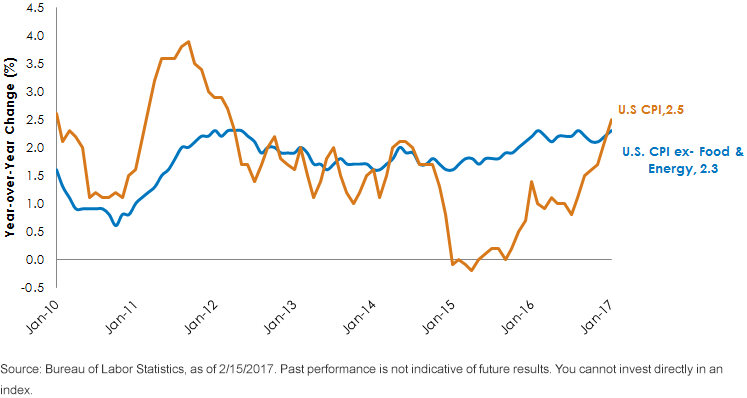In Like a Lion?


The fixed income arena seems to be facing an interesting dilemma as the calendar turns to March. Will the money and bond markets have to weather the storm from potentially higher rates, or will the storm clouds part as monetary policy developments here in the U.S. give way to the upcoming elections in the Netherlands and France?
As we witnessed around last year’s Brexit vote, uncertainty abroad can impact the Federal Reserve’s (Fed) decision-making process, and coincidentally, the Dutch general election takes place on March 15, the exact same day as the next FOMC meeting. This election will be followed by the French presidential election, slated for April 23, only 10 days prior to the May FOMC policy gathering.
U.S. CPI vs. U.S. CPI ex-Food & Energy
Year-over-Year Change from 1/31/2010 to 1/31/2017

However, if the Fed leans more in the direction of domestic economic factors, the recent inflation reading from the Consumer Price Index (CPI) will more than likely be an integral point of discussion. The FOMC looks at policy based upon its dual mandate: maximum employment and price stability. While the employment aspect has not been in doubt, the inflation component—or lack thereof—has been the factor the Fed has had difficulty coming to grips with.
The aforementioned January CPI report revealed that overall inflation rose at a year-over-year rate of +2.5%, the highest in almost five years. This compares to the 2016 low point of +0.8% in July and even negative readings less than two years ago. Certainly, the rebound in energy prices from levels witnessed 12 months ago played a role in this higher-than-expected reading, but perhaps more important from the Fed’s perspective was the upside seen in the core measure, CPI ex-food and energy. Indeed, core CPI rose at an annual rate of +2.3%, reflecting gains in both the goods and services groupings. While the monthly increase in core services was in line with recent trends, the gain for core goods was a surprise, because not only did it reverse a string of weak performances, it was also the highest reading since 2011.
Even though the Fed will not make a policy decision based upon a single month’s worth of data, this CPI report did leave its mark on the money and bond markets. Indeed, the inflation figures give rise to the possibility that price pressures could finally be on the verge of building, but more data will be needed to reflect that determination. For the record, the Fed’s preferred measure for inflation is the price index for personal consumption expenditures, which has been on an upward trajectory itself, albeit from rather low readings as well.
Conclusion
The question is whether the Fed will wait to see “the whites of inflation’s eyes” or take a more proactive approach. Barring any unforeseen developments, the odds favor the Fed continuing on its rate hike path in 2017, with the only unknown being the exact timing and magnitude. With that in mind, investors may wish to insulate their portfolios from the potential for rising rates. The WisdomTree Interest Rate Hedged High Yield Bond Fund (HYZD) and the WisdomTree Barclays Interest Rate Hedged U.S. Aggregate Bond Fund (AGZD) are two vehicles investors can utilize to achieve this goal. These Funds can be used as a complement to a “core” fixed income strategy or as standalones for that approach.
Investors looking to mitigate potential interest rate exposure may also wish to examine the benefit of floating rate Treasury notes (FRNs). Given the outlook for the Fed Funds Rate in 2017, some “Fed protection” seems warranted. Against this backdrop, we feel that by utilizing a floating rate product such as the WisdomTree Bloomberg Floating Rate Treasury Fund (USFR), investors may be better able to insulate their bond portfolio as compared to a more traditional short-duration and/or inflation-protected fixed income investment.
Unless otherwise noted, all data is from the Bureau of Labor Statistics as of February 15, 2017.
Important Risks Related to this Article
Fixed income investments are subject to interest rate risk; their value will normally decline as interest rates rise. In addition, when interest rates fall, income may decline. Fixed income investments are also subject to credit risk, the risk that the issuer of a bond will fail to pay interest and principal in a timely manner or that negative perceptions of the issuer’s ability to make such payments will cause the price of that bond to decline.


